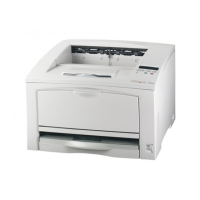1-4 Service Manual
4022-XXX
Principles of Operation
Overview of Print Process
The printer provides a electrophotographic process function to print image on paper with
video signals sent from the controller board to the engine board. The electrophotographic
process consists of the following seven steps.
1. Charge - Equally assigns negative charge on the drum surface by the bias charge
roll.
2. Exposure - The laser scanner scans the drum surface and generates an invisible
electrostatic latent image on the drum surface using super-fine laser beams
modulated according to signals sent from the controller.
3. Development - Draws toner toward an electrostatic latent image on the drum
surface and creates a visible toner image.
4. Transcription - Transcribes a toner image from the drum surface to paper.
5. Exfoliation - Cast off paper from the drum surface by partially neutralizing charge on
paper.
6. Fusing - Permanently fuses a toner image by heat and pressure.
7. Cleaning - Eliminates the remaining toner from the drum surface.
Rotating the drum, the drum surface passes six steps (charge, exposure, development,
transcription, exfoliation, and cleaning), creates a toner image, and transcribes the
created image on paper. Paper passes three steps (transcription, exfoliation, and fusing)
by the paper transfer mechanism. When paper is positioned as shown in image, toner
image is transcribed from the drum surface to paper, and then fused.
1. Charge
2. Exposure
3. Development
Paper Enters
4. Transfer
5. Detack
6. Fusing
Paper Exits
7. Cleaning
Xerographic cycle
Cycle repeats for the next print

